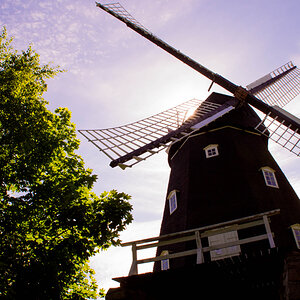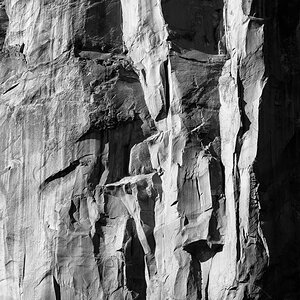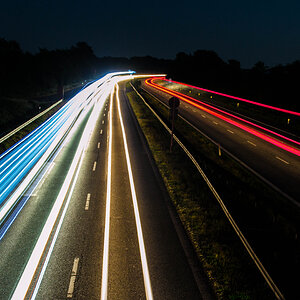l0de
TPF Noob!
- Joined
- Feb 23, 2009
- Messages
- 1
- Reaction score
- 0
- Can others edit my Photos
- Photos OK to edit
I have a somewhat atypical problem, possibly more involved with scanning and imaging than photography. I have been working on it for a while and am getting frustrated, any help would be greatly appreciated. I am not a photographer by trade, this problem has sort of fallen into my lap, and I am unable to pass the buck. 
As part of an installation, I am tasked with fulfilling an artist's vision of having several people roaming around the space, scanning the art on the walls, photoshopping the content, printing out their modification on sticker paper on the spot, then affixing it to the walls. The artist wants each person to have a 'mobile station' and to be completely self-contained, so they can work without interruption. It sounds goofy, but I think it does have the potential to be really interesting, as he has a pretty interesting guest list of local artists.
The printing and photoshop parts I've been pretty successful with, I got a good deal on several macbooks and wacom tablets, built little wheeled workpods that people can scooted around the warehouse and have tested several mobile printers that are acceptable. So far so good. Of course, I am not allowed anything so 'barbaric' (the artist's actual words ) as cords going to the pods, so I've been working with devices that have built in batteries so far. Thus far I have been able to escape putting car batteries and inverters in the stations, and I would like to keep it that way, but if I have to, I will (I built a compartment into the pods anticipating this possibility).
) as cords going to the pods, so I've been working with devices that have built in batteries so far. Thus far I have been able to escape putting car batteries and inverters in the stations, and I would like to keep it that way, but if I have to, I will (I built a compartment into the pods anticipating this possibility).
I'm stuck on the scanning.
My initial thought was to use Canon lide-200 scanners, remove the lids, install rubber feet so the glass doesn't get scratched, then install handles on the backs of them so that people can hold them against the wall to scan what they want. The canon lide 200s are even bus-powered, and they're lightweight enough that people shouldn't have much trouble holding them up. Scan time at 600dpi is only about 30 seconds.
But (did you guess it?) that didn't work. Everything comes out way too dark and blurry. But when I scan things with the lid on in the normal way, they're fine. So it's an issue with the wall being too far from the scanning element, right? I'm going to be taking my test model apart later to see if I can somehow rig it to have the glass flush with the walls (which will probably lead to issues with scratching that I'll have to resolve), and see if that fixes the issue, but I'm not sure if I can make that work without completely ripping these things apart and rebuilding them. So that's an option, albiet a fairly labor intensive one. I'm also considering filing down the housing some to get it flush, not sure. (I'm kind of leery of breaking these too, because I am going to take a major bath on all of this if I can't get it working right).
Now if anyone thinks this isn't a blind alley, I could also try a different scanner, it's possible a regular one (not a bus-powered ultra mobile model) would be more forgiving. not sure on this.
I've approached some of my friends about the problem, and pretty much all of them are telling me to just use digicams and tripods. Well I tried this, and it's really, really hard to get it to work. The lighting conditions in the warehouse vary a lot. Also the artist hates the tripods, he wants people to "experience" physically holding a capturing device against the wall. (but has offered no better suggestions on how to make this work )
)
I was thinking (if I had to go this route) of building sort of a wall mount for the cameras, like a plexiglass frame with a cutout indicating where the actual area captured by the camera would be, that people could hold against the wall, with legs that attach to the camera, holding it steady. This way I can assure that there's a fixed distance to the wall, and hopefully set the cameras up all the same.
However the issues I face here are:
A: lens distortion (is this easily correctable?)
B: the changing lighting conditions (which would possibly require me to set up lighting on all the pods to make things uniform, which I haven't even bothered to ask the artist about, his answer will certainly be no).
C: people mucking up the camera settings
D: the whole thing being much heavier, and less palatable to the artist than a scanner, and producing worse images.
Also I'd have to buy 7 cameras, build 7 of these frames. The scanners I was hoping to use were $100 a pop, and were usb bus powered.
Anyhow, sorry for the long post, any help, especially from someone with a lot of scanner experience would be greatly appreciated.
As part of an installation, I am tasked with fulfilling an artist's vision of having several people roaming around the space, scanning the art on the walls, photoshopping the content, printing out their modification on sticker paper on the spot, then affixing it to the walls. The artist wants each person to have a 'mobile station' and to be completely self-contained, so they can work without interruption. It sounds goofy, but I think it does have the potential to be really interesting, as he has a pretty interesting guest list of local artists.
The printing and photoshop parts I've been pretty successful with, I got a good deal on several macbooks and wacom tablets, built little wheeled workpods that people can scooted around the warehouse and have tested several mobile printers that are acceptable. So far so good. Of course, I am not allowed anything so 'barbaric' (the artist's actual words
I'm stuck on the scanning.
My initial thought was to use Canon lide-200 scanners, remove the lids, install rubber feet so the glass doesn't get scratched, then install handles on the backs of them so that people can hold them against the wall to scan what they want. The canon lide 200s are even bus-powered, and they're lightweight enough that people shouldn't have much trouble holding them up. Scan time at 600dpi is only about 30 seconds.
But (did you guess it?) that didn't work. Everything comes out way too dark and blurry. But when I scan things with the lid on in the normal way, they're fine. So it's an issue with the wall being too far from the scanning element, right? I'm going to be taking my test model apart later to see if I can somehow rig it to have the glass flush with the walls (which will probably lead to issues with scratching that I'll have to resolve), and see if that fixes the issue, but I'm not sure if I can make that work without completely ripping these things apart and rebuilding them. So that's an option, albiet a fairly labor intensive one. I'm also considering filing down the housing some to get it flush, not sure. (I'm kind of leery of breaking these too, because I am going to take a major bath on all of this if I can't get it working right).
Now if anyone thinks this isn't a blind alley, I could also try a different scanner, it's possible a regular one (not a bus-powered ultra mobile model) would be more forgiving. not sure on this.
I've approached some of my friends about the problem, and pretty much all of them are telling me to just use digicams and tripods. Well I tried this, and it's really, really hard to get it to work. The lighting conditions in the warehouse vary a lot. Also the artist hates the tripods, he wants people to "experience" physically holding a capturing device against the wall. (but has offered no better suggestions on how to make this work
I was thinking (if I had to go this route) of building sort of a wall mount for the cameras, like a plexiglass frame with a cutout indicating where the actual area captured by the camera would be, that people could hold against the wall, with legs that attach to the camera, holding it steady. This way I can assure that there's a fixed distance to the wall, and hopefully set the cameras up all the same.
However the issues I face here are:
A: lens distortion (is this easily correctable?)
B: the changing lighting conditions (which would possibly require me to set up lighting on all the pods to make things uniform, which I haven't even bothered to ask the artist about, his answer will certainly be no).
C: people mucking up the camera settings
D: the whole thing being much heavier, and less palatable to the artist than a scanner, and producing worse images.
Also I'd have to buy 7 cameras, build 7 of these frames. The scanners I was hoping to use were $100 a pop, and were usb bus powered.
Anyhow, sorry for the long post, any help, especially from someone with a lot of scanner experience would be greatly appreciated.










![[No title]](/data/xfmg/thumbnail/36/36643-92fe0dd9e247722bfefe299cd8a549f5.jpg?1619737670)
![[No title]](/data/xfmg/thumbnail/32/32006-4103e122cb8d7b8d8e41a423124446b7.jpg?1619735151)
